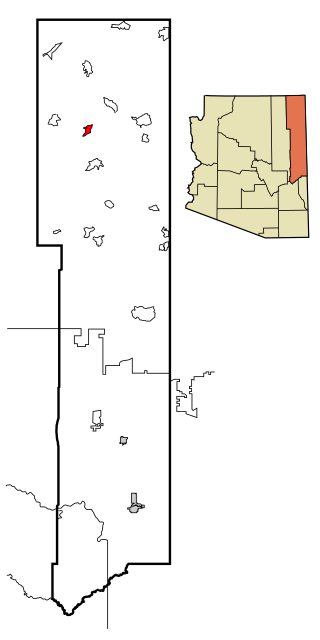Related Research Articles

Many Farms is a census-designated place (CDP) in Apache County, Arizona, United States. The population was 1,348 at the 2010 census.

Streptomycin is an antibiotic medication used to treat a number of bacterial infections, including tuberculosis, Mycobacterium avium complex, endocarditis, brucellosis, Burkholderia infection, plague, tularemia, and rat bite fever. For active tuberculosis it is often given together with isoniazid, rifampicin, and pyrazinamide. It is administered by injection into a vein or muscle.

Isoniazid, also known as isonicotinic acid hydrazide (INH), is an antibiotic used for the treatment of tuberculosis. For active tuberculosis, it is often used together with rifampicin, pyrazinamide, and either streptomycin or ethambutol. For latent tuberculosis, it is often used alone. It may also be used for atypical types of mycobacteria, such as M. avium, M. kansasii, and M. xenopi. It is usually taken by mouth, but may be used by injection into muscle.

The Columbia University College of Physicians and Surgeons is the medical school of Columbia University, located at the Columbia University Irving Medical Center in the Washington Heights neighborhood of Manhattan.

Management of tuberculosis refers to techniques and procedures utilized for treating tuberculosis (TB), or simply a treatment plan for TB.

Colin Munro MacLeod was a Canadian-American geneticist. He was one of a trio of scientists who discovered that deoxyribonucleic acid, or DNA is responsible for the transformation of the physical characteristics of bacteria, which subsequently led to its identification as the molecule responsible for heredity.

Livingston Farrand was an American physician, anthropologist, psychologist, public health advocate and academic administrator.

Eugene Anson Stead Jr. is best known as a physician, medical educator, and researcher. He served on the faculties at Harvard, Emory, and Duke universities. He is the founder of the physician assistant (PA) profession.
Harold Philip Lambert, FRCP was a British medical doctor and professor of medicine, known for his work dealing with infectious diseases and antibiotic therapy. He played a key role in the development of pyrazinamide as a treatment for tuberculosis and also did some of the earliest research into mescaline.
Christopher T. Walsh was a Hamilton Kuhn professor of biological chemistry and pharmacology at Harvard Medical School. His research focused on enzymes and enzyme inhibition, and most recently focused on the problem of antibiotic resistance. He was elected to the National Academy of Sciences in 1989.

Stuart Blank Levy was a researcher and physician at Tufts University. He was among the first to advocate for greater awareness of antibiotic resistance and founded the Alliance for the Prudent Use of Antibiotics.

John Friend Mahoney was an American physician best known as a pioneer in the treatment of syphilis with penicillin. He won the 1946 Lasker Award.
Dorothea Cross Leighton was an American social psychiatrist and a founder of the field of medical anthropology. Leighton held faculty positions at Cornell University and the University of North Carolina and she was the founding president of the Society for Medical Anthropology. She and her husband, Alexander Leighton, wrote The Navajo Door, which has been described as the first written work in applied medical anthropology.

Frederick J. Bancroft was a surgeon during the American Civil War before he settled in Colorado, where he was considered to be "one of the most prominent physicians", according to a San Francisco Chronicle obituary. In the late 1870s, he and the Denver Medical Association created the public health system for Denver, Colorado to improve the health of its citizens. In 1876, Bancroft was the first president of Colorado's State Board of Health. He became Colorado Medical Society president in 1880. Bancroft was a founder and professor of the University of Denver and Colorado Seminary Medical Department in 1881.
The Denver Medical Society is the "Rocky Mountain region's oldest and largest local medical society" It was founded in 1871 to improve public health through education and professional standards. It tackled issues such as epidemics, tuberculosis, and development of sanitation systems, including initiating the construction of the systems sewer system. Between 1889 and 1902, its scope included Arapahoe County. Then, it returned to an organization focused on the city and county of Denver.
Paul Bruce Beeson was an American physician and professor of medicine, specializing in infectious diseases and the pathogenesis of fever.
Alasdair Macintosh Geddes was a British medical doctor who was Professor of Infection at the University of Birmingham Medical School. In 1978, as the World Health Organization (WHO) was shortly to announce that the world's last case of smallpox had occurred a year earlier in Somalia, Geddes diagnosed a British woman with the disease in Birmingham, England. She was found to be the index case of the outbreak and became the world's last reported fatality due to the disease, five years after he had gained experience on the frontline of the WHO's smallpox eradication programme in Bangladesh in 1973.

The Edinburgh City Hospital was a hospital in Colinton, Edinburgh, opened in 1903 for the treatment of infectious diseases. As the pattern of infectious disease changed, the need for in-patients facilities to treat them diminished. While still remaining the regional centre for infectious disease, in the latter half of the 20th century the hospital facilities diversified with specialist units established for respiratory disease, ear, nose and throat surgery, maxillo-facial surgery, care of the elderly and latterly HIV/AIDS. The hospital closed in 1999 and was redeveloped as residential housing, known as Greenbank Village.

George Bellamy Mackaness was an Australian professor of microbiology, immunologist, writer and administrator, who researched and described the life history of the macrophage. He showed that by infecting mice with intracellular bacteria, macrophages could be activated to attack other bacteria, triggering further research on "macrophage activation", a term he has come to be associated with.

Adeel Ajwad Butt is a Pakistani–American infectious diseases physician, Professor of Medicine and Population Health Sciences at the Weill-Cornell Medical College He is also the founder president and CEO of Innovations in Healthcare Advocacy, Research and Training (I-HART).
References
- 1 2 3 4 5 Beeson, P. "Walsh McDermott". Royal College of Physicians . Retrieved January 9, 2020.
- 1 2 3 Clark, Alfred E. (October 19, 1981). "WALSH MCDERMOTT, MEDICAL RESEARCHER, DIES". The New York Times . Retrieved January 9, 2020.
- 1 2 3 Beeson, Paul B. (1990). "Walsh McDermott". Biographical Memoirs: V.59. National Academies Press. pp. 282–307. doi:10.17226/1652. ISBN 978-0-309-04198-0.
- ↑ Hobby, Gladys L. (1982). "In Memoriam: Walsh McDermott, M.D., 1909–1981". American Review of Respiratory Disease. 125 (2): 141–143. doi:10.1164/arrd.1982.125.2.141 (inactive 1 November 2024). PMID 7039436.
{{cite journal}}: CS1 maint: DOI inactive as of November 2024 (link)